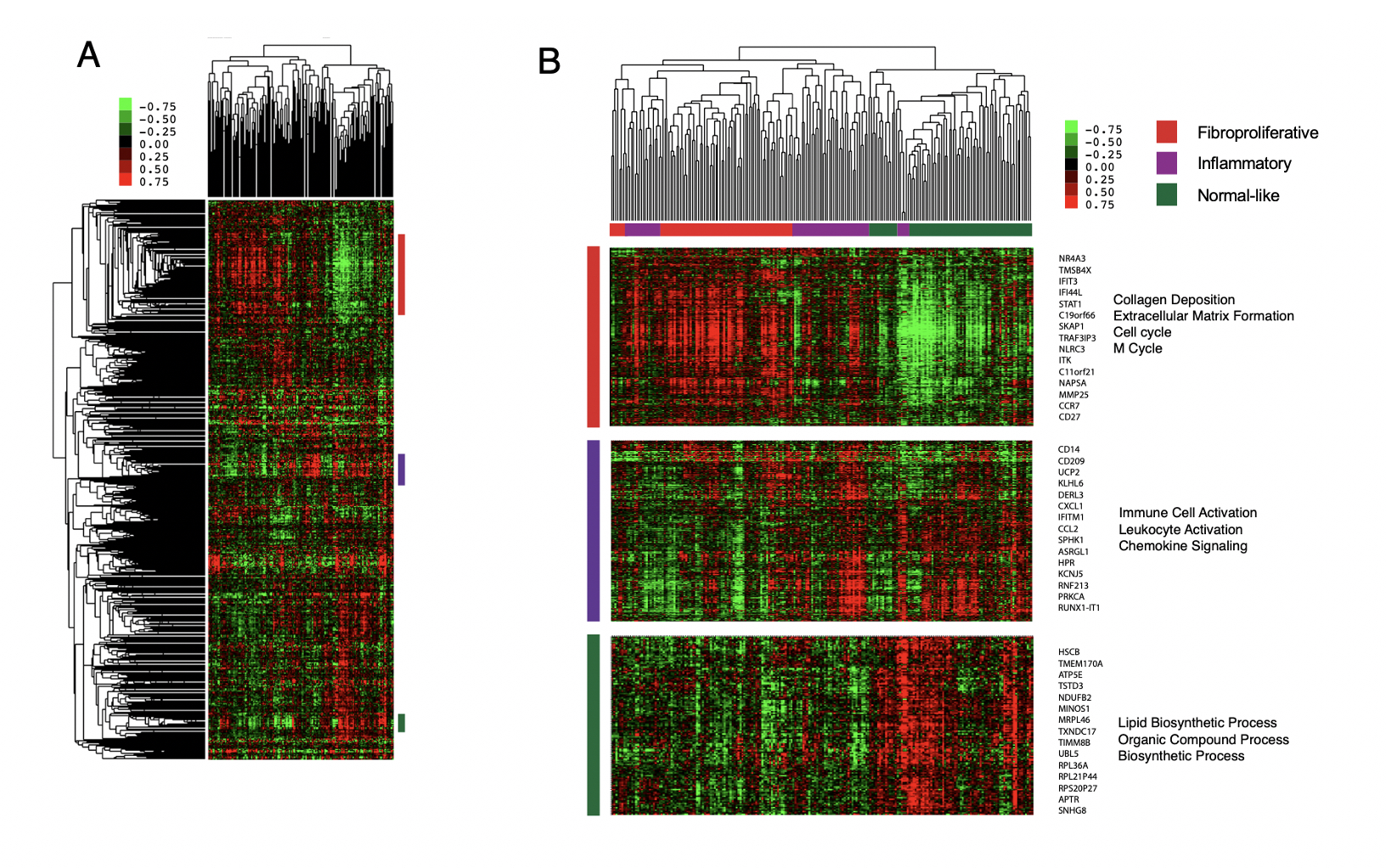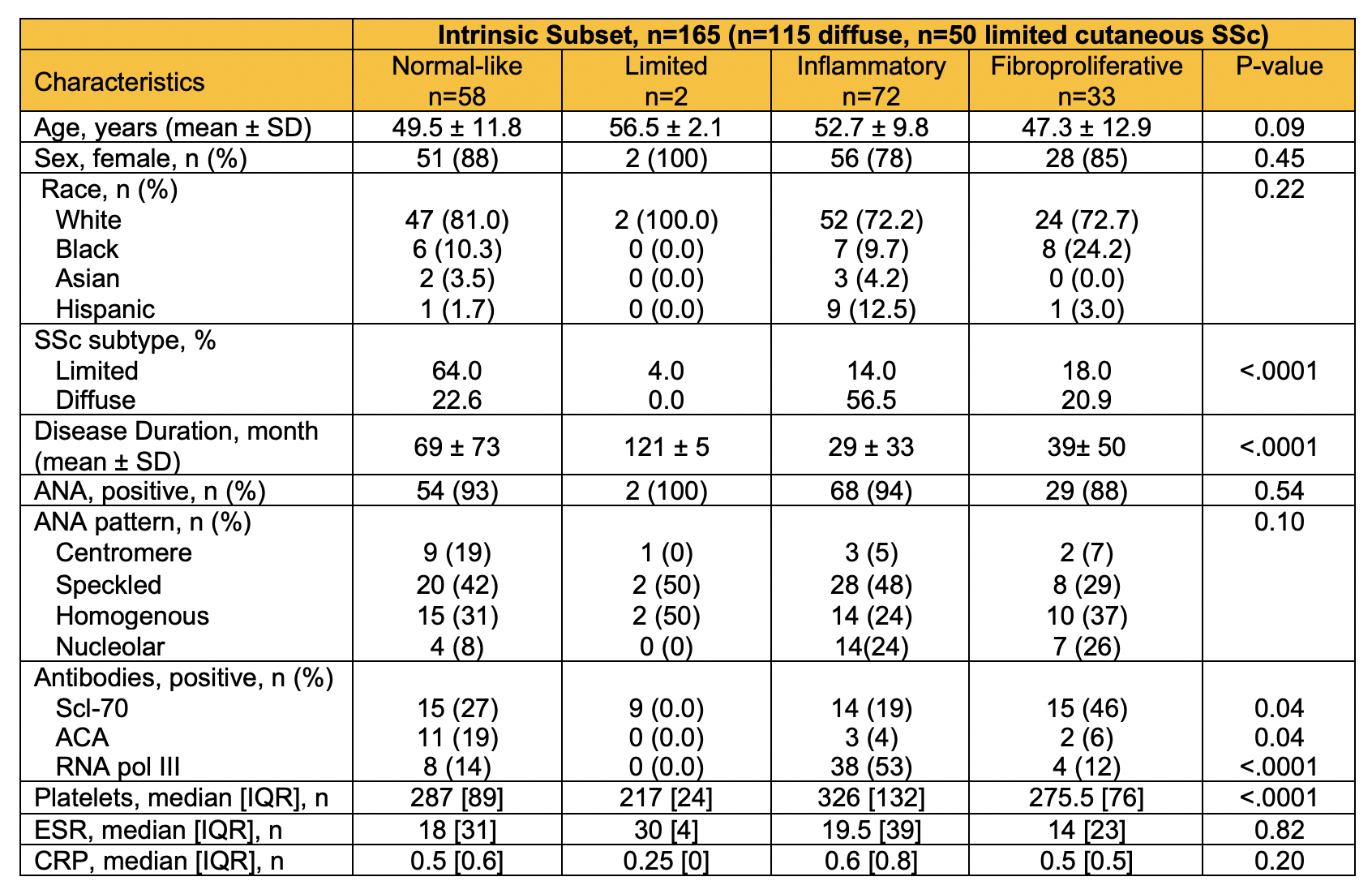Session Information
Date: Saturday, November 6, 2021
Title: Abstracts: Systemic Sclerosis & Related Disorders – Clinical (0496–0501)
Session Type: Abstract Session
Session Time: 4:30PM-4:45PM
Background/Purpose: Although two subsets in systemic sclerosis (SSc) have been identified based on degree of skin disease, the current classification system, limited vs. diffuse cutaneous, does not reliably predict which patients will develop progressive skin fibrosis and internal organ involvement. Genome-wide analysis of gene expression in the skin has been used to classify patients with SSc into four intrinsic gene expression subsets: fibroproliferative, inflammatory, limited, and normal-like. The objective of this study was to characterize and define the clinical characteristics and markers of disease severity based upon intrinsic subset.
Methods: Subject-level data were prospectively obtained for SSc patients and healthy controls who underwent skin biopsies. Patients fulfilled the ACR/EULAR 2013 classification criteria and had clinically active disease determined by one treating physician. Paired skin biopsies of the forearm were performed: one for histology and one for DNA microarray analyses to measure gene expression. Intrinsic subsets were assigned using a trained Glmnet machine learning classifier. Clinical information including laboratory, pulmonary function test, chest high-resolution computer tomography (HRCT), echocardiography and patient-reported outcomes (PROs) were collected at baseline and longitudinally. Statistical analysis was performed to compare clinical characteristics and markers of disease severity between intrinsic subset groups (SAS, town and state).
Results: 223 participants (165 SSc and 58 control) were categorized by intrinsic subtypes (Figure 1). Demographic and clinical characteristics of SSc patients by intrinsic subset are shown in Table 1. Normal-like subset had significantly more limited cutaneous patients (p< 0.001) and longer disease duration (p< 0.001). SSc antibodies differed by subsets with ACA, Scl70 and RNA poly III associated with normal-like (p=0.04), fibroproliferative (p=0.04) and inflammatory (p< 0.001) subsets respectively. Pulmonary, cardiac and PROs by intrinsic subset are shown in Table 2. Inflammatory subset had significantly higher modified Rodnan skin scores (p< 0.001). Fibroproliferative subset had a trend toward worse lung fibrosis scores and significantly more ILD present on HRCT (p=0.04). For PROs, inflammatory and fibroproliferative subsets scored worse in fatigue, sleep disturbance, social participation and pain domains (p< 0.04) compared to patients in limited or normal-like subsets.
Conclusion: This study utilized molecular signatures in the skin to classify SSc patients into distinct subsets that had significantly different clinical characteristics. Patients in the normal-like subset were more likely to have limited cutaneous disease and longer disease duration, suggesting milder disease. The inflammatory subset had more severe skin disease and the fibroproliferative subset had more significant fibrotic lung disease. Both inflammatory and fibroproliferative patients endorsed worse PROs than their normal-like counterparts. This study elucidates the clinical relevance of distinct molecular subsets in the skin and contributes to the growing effort to better define and characterize the vast heterogenicity in SSc.
To cite this abstract in AMA style:
Yang M, Goh V, Espinoza M, Yuan Y, Lee J, Carns M, Khanna D, McMahan Z, Whitfield M, Hinchcliff M. Clinical Phenotypes of Patients with Systemic Sclerosis with Distinct Molecular Signatures in the Skin [abstract]. Arthritis Rheumatol. 2021; 73 (suppl 9). https://acrabstracts.org/abstract/clinical-phenotypes-of-patients-with-systemic-sclerosis-with-distinct-molecular-signatures-in-the-skin/. Accessed .« Back to ACR Convergence 2021
ACR Meeting Abstracts - https://acrabstracts.org/abstract/clinical-phenotypes-of-patients-with-systemic-sclerosis-with-distinct-molecular-signatures-in-the-skin/



